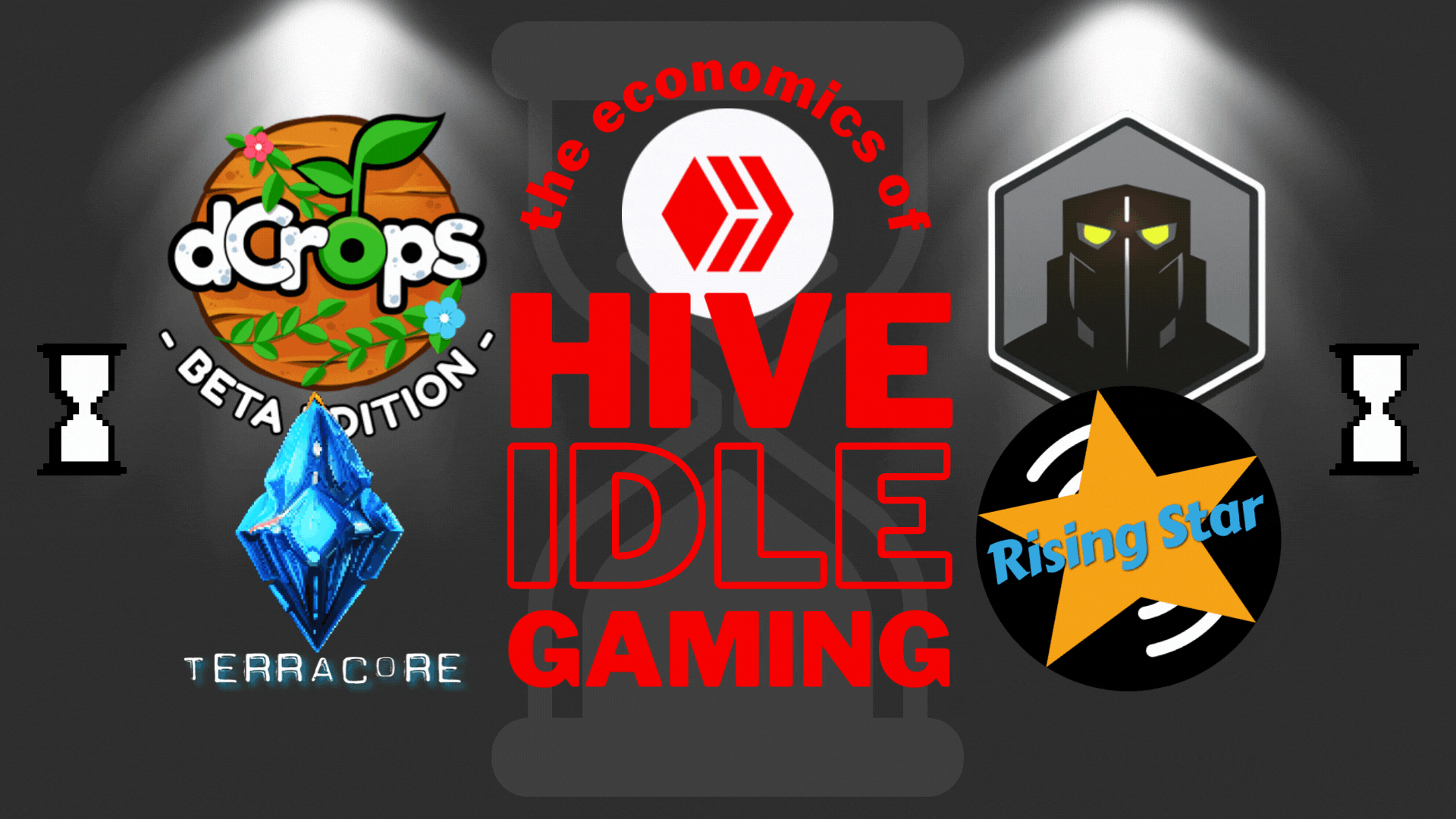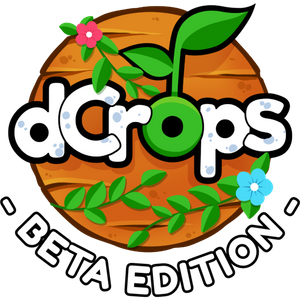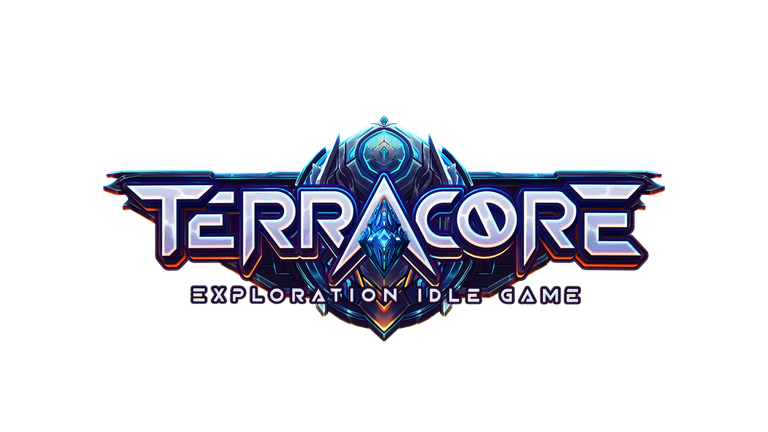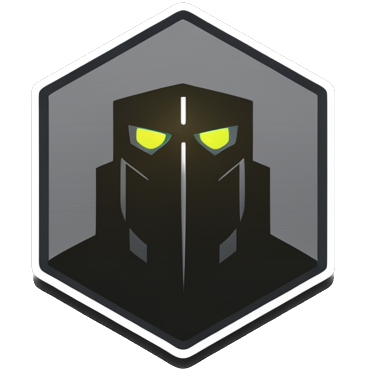The Economics of HIVE Idle Gaming

It’s been an exciting year for idle and incremental games on Hive. Milestones for some of the games I play include:
- 🌟 Rising Star turns 3 years old, introduces 2-3 new major game modes
- 🌱 dCrops turns 2 years old, releases cooking and special events
- 🚀 Terracore launches, and rapidly co-creates features with the community
- 🤖 Golem Overlord launches, inspired by Terracore, with a vision of complex theorycrafting
Each of these games is similar in some respect, but each has its own flavour and speed. The first two are “established” with no PvP, the latter two are brand new, include PvP and take very different approaches to production of tokens.
This creates a lovely and fascinating range of behavioural economics to explore—how do users, bots, and quasi-organizations (e.g. guilds, multi-account farms) respond to incentives, markets, gamification, and loopholes?
Let’s get into it!
📜 Some terms to start us off
To frame this discussion (and avoid too many tangents), I want to look at each game through some defined lenses:
- Behavioural economics. These are the psychological, cognitive, emotional, cultural and social factors that govern how people act within the games. They are rarely aligned with hyper-rational, carefully calculated economic decision making or risk management.
- Faucets. How game currencies are created. AKA production, which in Web3 games, is usually a tradable token.
- Sinks. How game currencies are spent or burnt. AKA costs, which in Web3 games, is usually a tradable token.
There are ton of other terms we could explore, but the simple interplay between faucets, sinks, and their markets gives us a rich landscape to start to explore behavioural economics.
🕹 The PvE games

🌟 Rising Star / @risingstargame / Lead dev: @atomcollector
Overview
The most senior of games on review is Rising Star—the indie music incremental that begins with a single, simple mission: Press the [START] button on the Illegal Busking mission and never look back!
The core game involves pressing this button, waiting for a timer, then collecting rewards. As you do missions, you gain XP, which unlocks more missions. Eventually, the mission requirements force you to buy some NFTs to boost Fan count (unless you are really dedicated to the grind).
Rising Star Faucets
This cycle of missions produces the $STARBITS token, which begins life as a centralized “score” on the game but can be withdrawn to your Hive Engine wallet as Layer 2 token. As you get access to better missions, and as your Fan count rises, the $STARBITS faucet gets bigger, on a linear scale—this has led to an inflationary problem, which we’ll discuss in a moment.
The other game currency, $STARPRO, has a faucet limit: only 100 can ever be made per day by users (and I believe the game creates some per day for itself). This is done by playing the Music Promoter Minigame. The $STARPRO economics are largely intended to counter the $STARBITS inflationary problem.
Rising Star Sinks
The problem comes from the sink-faucet mismatch. There weren’t many highly incentivized $STARBITS sinks. The main one is the 12-pack of NFTs. For 100,000 $STARBITS, you can get 36 random game NFTs. These NFTs often give you Fans, which increase $STARBITS production. Because the sink price stays the same (instead of maybe being pegged to a $USD price or something), this creates an ever-growing cycle of $STARBITS production growth for users who have the time or money to pump into it.
Enter the $STARPRO sink strategy. Because the only way to create new $STARPRO is to spend $STARBITS in the music promoter, if the game can create way more sinks for $STARPRO than the faucet, eventually this will act as indirect sink for $STARBITS too.
If I can grow my account faster, or earn better, or have more fun in the game by spending my $STARBITS on $STARPRO, then I won’t be using those BITS to grow my BITS production.
Getting this balance right, making it sustainable, etc.—all tough game design strategy problems for the RSG development team. But they’re known for taking things slow, testing extensively, and making sound decisions.
Rising Star Behavioural Economics
So how do people behave within the way RS has been set up? This will generally depend on people’s goals, but we can safely assume that a majority of Web3 gamers will seek some balance of “fun” and “earn.” Human nature suggests that the drive to “earn” may be stronger (and be its own source of fun).
Earning in this case is some combo of creating $STARBITS, $STARPRO, and with the release of Raves—directly winning $SWAP.HIVE.
The clever strategy Rising Star has set up right now is:
- To boost $SWAP.HIVE winnings from Raves, you need $STARPRO
- To get $STARPRO, you either buy it on the market or burn $STARBITS
- To get $STARBITS, you either buy it on the market or play the main game loop
So one can either play through this system, or hope that there’s enough buy pressure from said system to create “capital gains” from buy-low sell-high moves on the markets.
But this only works if the prizes from Raves are worth it, and if enough people are participating in this system to generate word of mouth and social proof that it’s both fun and has earning potential.
Another angle is for people to try and automate the process—the ever present bots and botnets. Clicker games and idlers are especially prone to these tactics, since the core behaviour is in taking simple actions (clicking) over and over. Repeat-actions in predictable patterns are perfect for scripting, and therefore those with the skills are all too eager to try.
Of all the games in this post, Rising Star is the most strict on cracking down on botters and multi-accounts. To the point of testing the limits of some users’ philosophies on what a web3 game should even be! It is tough to sneak past Rising Star’s systems to detect automated accounts.
🌱 dCrops / @dcrops / Lead dev: @scriptkittie

Overview
This farming simulation uses many different NFTs that work together to, well, farm stuff! You plant seed NFTs onto land NFTs, and wait for the timer to expire to harvest them. A system of crafting the basic items into more valuable stuff is being added piece by piece.
dCrops Faucets
The primary way to obtain the game’s $CROP token is to “sell” your in-game crops. This is a centralized in-game action. The game assigns you points for this, called Shares. At the end of each dCrops season (every 15 days), a fixed amount of $CROP is divided proportionally to those with Shares. The fixed $CROP pool also decreases a small amount every cycle.
This arrangement rewards early adopters and, unlike Rising Star’s $STARBITS, will necessarily limit the amount of $CROP token that is created by gameplay. Furthermore, it’s possible to calculate exactly how much $CROP can exist.
A big faucet system actually involves $SWAP.HIVE—every cycle people who hold dCrop game assets (both NFTs and in-game items) are airdropped a nice amount of $SWAP.HIVE.
dCrops Sinks
Interestingly, the game itself doesn’t offer many $CROP sinks. You can buy NFT packs using $CROP from the game store, but it also accepts several other Hive crypto tokens. The secondary market operates in both $SWAP.HIVE and $CROP.
The economic model here is much different than Rising Star!
dCrops Behavioural Economics
Because of the somewhat limited (and slow) $CROP faucet and sink system, a lot of the behaviour may revolve around the $SWAP.HIVE faucet. The Fun vs Earn desires also look different here.
For one thing, the timers on dCrops can range from 24 hours to 12 days! Others can be shorter, longer, but most fall into that span. Therefore, dCrops progression moves quite slowly. This will attract (and repulse) certain kinds of gamers.
To Earn on dCrops, the most straightforward way is likely the Holding Rewards system, which at the time of writing has an APR of roughly 20%. So if you hold 100 $SWAP.HIVE worth of dCrops assets, you’ll get airdropped about 20 $SWAP.HIVE per year.
You can also earn by generating and maybe selling $CROP token, but because there aren’t many $CROP sinks, the demand for the token is not enormous.
Once dCrops allows more player NFT creation (there are basic systems in operation right now), this will also be a very interesting path to earning. If you have big Holding Rewards, you also get more in-game items by doing Quests, which gives you more raw materials to refine into desirable NFTs, etc.
The game will literally change once crafting components are all made into player-mintable NFTs!
Botting dCrops is definitely possible, but the timer cycles are quite slow, and the optimization of planting cycles feels like it might be a bit too complex to build a massive farm around. The nature of the fixed reward pool of $CROP may also discourage multi-accounts, since it doesn’t make much difference if your assets are spread across 100 accounts or consolidated into one—the rewards are still the same.
(Some folks successfully gamed the system by multi-accounting the special Event raffle system, but that’s a new aspect of the game which has only been run twice, so it will likely change over time.)
⚔ The PvP games
These next two idlers introduce Player vs Player (PvP) mechanics, as well as increasing token production mechanics for every account. This creates totally new economic models that tend to move a LOT faster than the last two games.
🚀 Terracore / @terracore / Lead dev: @crypt0gnome

Overview
Simple at glance, with deeper complexity being added all the time, Terracore starts you off on a desolate planet with a meager mining income of $SCRAP and level 1 stats. Your starter $SCRAP can be used to upgrade those stats, which in turn increase your $SCRAP production one way or another.
Terracore Faucets
The only way anyone can make new $SCRAP is by creating an account and leveling up their Engineering skill. The amount that you make has changed multiple times, and as the game is in Alpha, I’d expect it to change further. What is key to behavioural economics is that each new account will mine new $SCRAP.
Game mechanics wise, every second you gain some new $SCRAP into a “Stash.” Every four hours, you are allowed to “Claim” your Stash into your Hive Engine wallet, and you can save up to five Claims maximum.
Unclaimed $SCRAP can be stolen by other players! Who you can steal from depends on everyone’s Attack and Defense stats. This also has some pretty serious implications for how people behave.
There is also a new Terracore currency called $FLUX, which is obtained by burning NFTs.
Terracore Sinks
There are oodles of $SCRAP sinks. Almost everything in the game right now costs $SCRAP including your critical stats and NFT crates. And there will likely be even more sinks coming in the future.
Terracore Behavioural Economics
So many interesting behaviours arise out of this simple structure.
First, the speed. Mining happens by the second, and Claims and Attacks (and now Boss Fights) can happen many times a day. This keeps people close to the game. It’s not the best kinda game for very passive Players.
Second, the PvP. When you’re facing off against a whole mass of other Players, the psychology of the entire interaction shifts. Being able to lose your assets, having them being stolen—this brings a lot more emotion into the equation. Cliques and guilds can form. Money might be pumped in in the name of revenge or to try to catch up or whatever.
The simple Attack-Defense system creates natural tiers of interaction too. Basically, you can attack anyone who has a lower Defense than your Attack. The amount stolen is random, currently with a stat that sets a minimum steal % for the Attacker. And because your number of Attacks are limited, high level players tend to want to try to steal from other high level players (bigger stashes, usually). Mid level players want to attack mid-level (they can’t “reach” the high level), and so on.
The botting and multi-account incentive is massive here. Because every account starts with some mining power, creating a new account (which has a cost) can sometimes be more lucrative than focusing on a single high-level account. The mine rate has been tweaked to avoid both exponential and diminishing returns—the former breaks the game and the latter encourages multi-accounting at a certain point.
Being such a new game, there’s tons of room to grow into new features, game modes, and ways to tweak the economic engines to try to influence general behaviour. Watching this happen in real-time is fascinating, and Terracore is a great community to get involved in if you want to watch these discussions happen fast and furious 🙂
🤖 Golem Overlord/ @golem.overlord / Lead dev: @yuexn

Overview
Inspired directly by Terracore, Golem Overlord started out looking quite the same: mining for $PART, some Attack and Defense stats, etc. Within a few short weeks though, it has evolved to become quite a different beast, creating perhaps the most complex behavioural economics puzzle of all the games I’ve covered so far.
Golem Overlord Faucets
The core $PART token follows the same Stash and Claim mechanic as Terracore’s $SCRAP. There is also PvP, albeit with way more complexity to consider. Claim timers do not stack up, but you can unlock the option to change the cooldown from 8 hours to 4, or 12.
The method for earning has also gone through enormous changes. An early revamp halted a dangerous exponential runaway situation—and now there's a linear decay model being tested. (Terracore uses a quadratic growth approach.)
Golem Overlord Sinks
What differentiates GO is the interwoven labyrinth of $PART sinks. Like Terracore, all major stats require $PART. These stats are not so straightforward, and some have been completely rewritten or changed (as the game is also in Alpha).
For example, one “stat” is Reputation, which slowly trickles $PART spent into a stat called XP, which classically levels you up. Levels have a multitude of impacts, changing cooldowns, $SHARD generation rate, stat boosters, as well as a path to Prestige, which is yet another layer. The “trickle” rate mentioned above is also dynamic.
That’s just levelling up. Production, defense, something called Faith… these are all interconnected through some creative math and interesting mechanics. Guilds are already in place, NFTs are coming… there’s a lot to take in.
Golem Overlord Behavioural Economics
Let’s start with botting and multi-accounting. GO sits somewhere between Rising Star and Terracore with their policies. Botting has been expressly forbidden, and multi-accounting allowed but with warning that it will be discouraged through game design.
The incentive to bot and multi-account are huge here, just like for Terracore, because of the fact that every new account starts off with a minimum $PART minting / production system. “Buying” an account essentially guarantees you an ongoing stream of assets, so long as you’re around to Claim them and Defend them from robbers.
The core of the economy does tend to revolve around this production mechanism. The more $PART you have, the more freedom you have to progress, participate and influence the secondary, market, etc. Hence, many behaviours will be anchored to this outcome (as mentioned before, Earning can be a lot of Fun on top of the Fun that comes from the game itself).
GO has a novel system in place to encourage gameplay progression over selling: you must spend at least 80% of the $PART you Claim on the game, somehow. If you don’t, you start to accrue severe penalties to your production, all the way down to zero (at which point, your only option would be to obtain $PART from someone else, e.g. buy some from the market). This ingenious little tweak rocked the whole community when it came out, forcing a ton of behaviour changes, which reflected heavily in the market price action.
Like Terracore, this PvP idlers is young—not even 2 months old at the time of writing. This is another fascinating place to watch for deep dive discussions on how game design can inspire behaviours, both good and bad.
In closing
By just looking at the interactions between faucets and sinks, you can start to unravel many questions about game design and behavioural economics. The Web3 angle creates a wide landscape for people both seeking Fun and Earnings, which is a very rich dimension that must take botting and multi-accounting into consideration.
- Play Rising Star here | Rising Star’s Discord
- Play dCrops here | dCrops Discord
- Play Terracore here | Terracore Discord
- Play Golem Overlord here | Golem Overlord / Splex Discord

Thanks for stopping by and reading. The hero image at the top was made with a Canva Pro License and uses the Leo Finance, Rising Star Game, dCrops, Terracore, and Golem Overlord logos.
Posted Using LeoFinance Alpha

Lots of new games in hive...
Thanks, this was very informative...
Wanted to create a GO account before but now I think I'll just go with dcrops..I don't have the to be watching my stash from any greedy players looking for an easy steal😂😂😂
I have a lot of Starbits though...
Hoping the economic growth increases with Rave thats just coming out...
There are all kinds of ways in GO to set yourself up to not have to worry too much about raids, but it does require some deeper theorycrafting (and the meta changes frequently enough so you'd need to keep up with it).
Curated and voted 100% by Selection of the best articles about Games and eSports in Hive
This post has been manually curated by Rising Star Game
The NFT based music career game built on HIVE
!PIZZA
@risingstargame, sorry! You need more to stake more $PIZZA to use this command.
The minimum requirement is 20.0 PIZZA staked.
More $PIZZA is available from Hive-Engine or Tribaldex